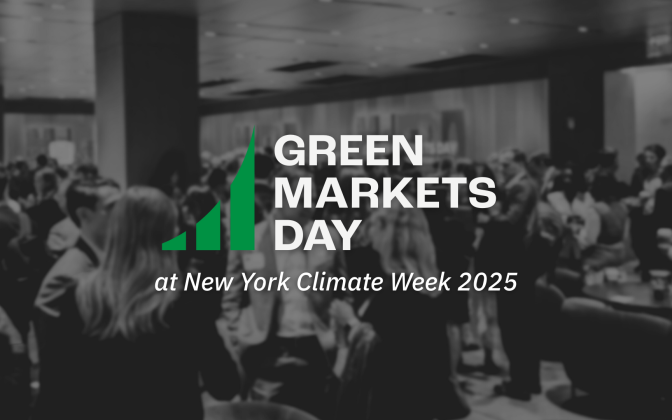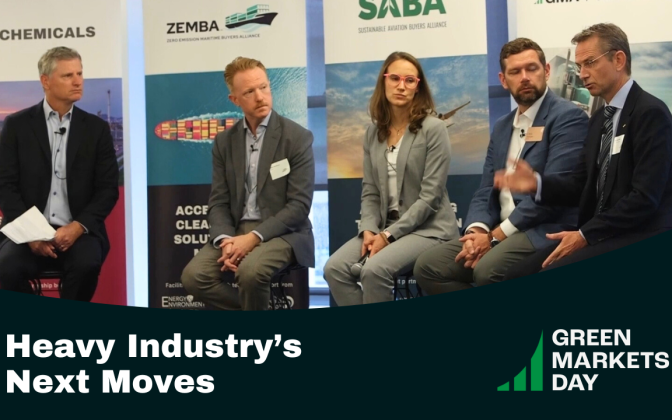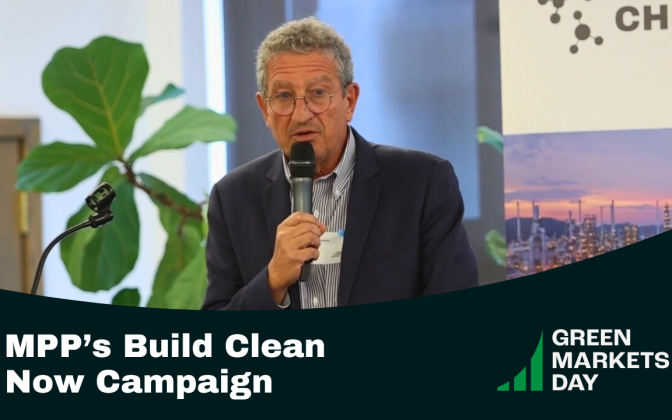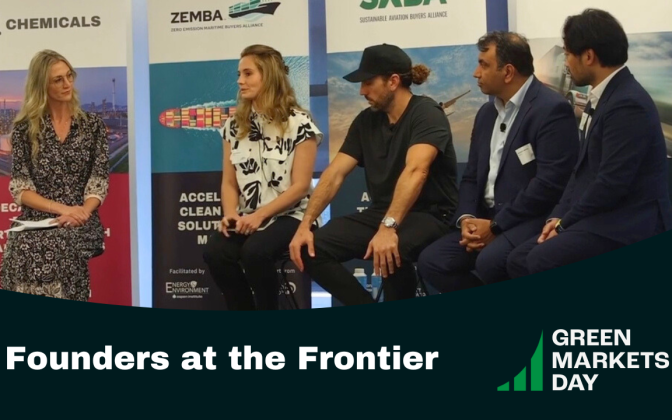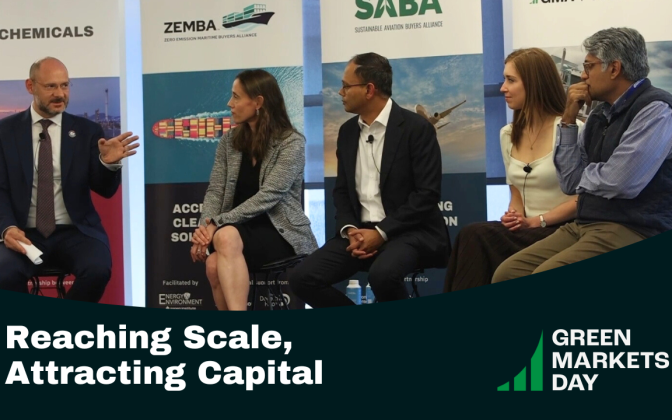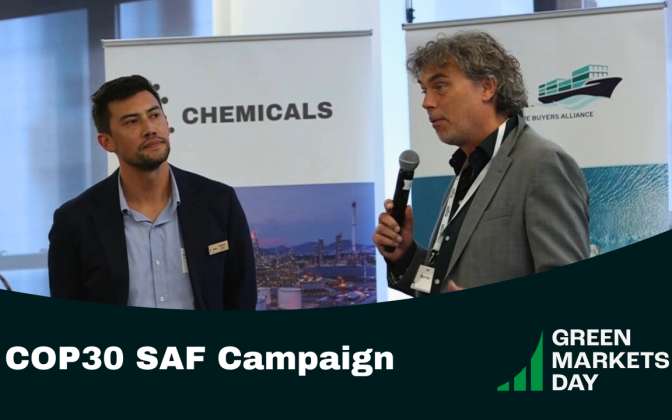10.29.25
Green Markets Day 2025 – Concrete Steps, Steel Resolve, and Clean Chemistry: Heavy Industry’s Next Moves
During Green Markets Day 2025, moderator Bryan Fisher, Managing Director at RMI, was joined by Chris Atkins, Director, Worldwide Operations Sustainability with Amazon, Leah Ellis, CEO and Co-Founder with Sublime, Johan Mandarić Reunanen, Climate Impact Lead with Stegra, and Hans Olav Raen, CEO with Yara Clean Ammonia.
See below for a full transcript.
BRYAN FISHER:
We’ve got four great innovative companies on the panel here. One buyer of low emissions commodities and three suppliers of low emissions commodities, all innovators in their own right. So that would be Amazon, Yara, Stegra, and Sublime.
So why don’t, just a couple of plugs before we start. One is I just want to announce the official launch of SCoBA, which is the Sustainable Concrete Buyers Alliance. We’re super excited about it. Thank you.
Could I actually get a show of hands for RMI and GMA folks that have been integrally involved in it? Please raise your hand. So if you want to know more, thank them for their hard work, first of all. And if you want to know more about it, please find them kind of after this session.
But we’re excited. It’s going to link, obviously, buyers that desire low emissions goods with suppliers that are creating innovative low emissions goods, backed by a high integrity book and claim system. So that’s what we’re all about. We’ve been working at it for quite a while, but our official announcement is actually today live. We issued a press release last Friday on it. So again, super excited about that.
And just a sneak preview, because we’re not quite ready to announce it, but we’ve made a lot of progress in the chemical space as well. And so we have had a number of active discussions. So please, in the next few months, we’re hopefully, with GMA and RMI partnership, launching something in that space.
So enough for the plugs. Let me get on to the panel here. And I’m going to have our esteemed panelists introduce themselves and their companies.
First, Chris of Amazon. You might want to explain who Amazon is, but maybe not. But you’ve been immensely supportive of RMI and GMA’s work in concrete. What does Amazon need from a group like the Sustainable Concrete Buyers Alliance? And what work do you see the alliance doing that Amazon can’t do on it, frankly, on its own?
CHRIS ATKINS:
Great question. And thanks, everybody, for being here. Thanks to RMI and GMA for putting this on and for launching the Buyers Alliance, which we think is integral to what we’re trying to do to bring scalability up to low carbon concrete.
So first of all, Chris Adkins, I’m the Director of Worldwide Operations Sustainability at Amazon. So our focus is on, how do we take our e-commerce division of our business and meet our sustainability targets? So my team works internal to the business units with them to be able to develop new solutions, but then also engaging with our external partners and our NGO partners to figure out how do we accelerate and kind of catalyze the pace of change to meet the climate ambitions that we all know are urgent right now.
And so when we look at that, you know, our fundamental belief is that there’s a mismatch of supply and demand. Over the last five, six years, we’ve seen tremendous reaction in industry to the climate crisis and commitment reaction in industry to the climate crisis and commitment to reach net zero emissions by many, many companies.
We co-founded the Climate Pledge in 2019 as our commitment to reach net zero by 2040, so 10 years ahead of the Paris Agreement, because we believe that we’re going to need leaders on the front edge of that to be able to transition the entire economy to meet the ambitions of the Paris Agreement.
Since that announcement, we’re really excited because we have over 600 co-signatories globally that are companies that see this as something that needs to happen. And we believe the power is not only one company. There’s no one company on Earth who can do the things that are necessary in order to usher in this change. And so the power is in these partnerships. And so we believe that’s really strong.
And with that, the demand is there. The supply for the low carbon solutions that we need is not yet at the production level that we need. And we all know, use the renewable energy example of where we were 15, 20 years ago in the renewable energy markets. When we are able to best match supply and demand, particularly through market-based mechanisms, we see how fast production capacity can grow. And with that, we accelerate learning curves and cost curves in a way that then catalyzes more and more adoption.
Buyers alliances are really critical. I assume I’m not really trying to sell too many people on that. If you’re at Green Markets Day and you have not been already sold to that, come find us afterwards. We’ll try to close you on this idea. But we really believe that what a buyers alliance can do can signal confidence that there are buyers ready to purchase the low carbon solutions that are needed to scale. And that gives confidence to the producers to go out and raise capital and build facilities and sell their products.
And so obviously you’ve got the examples behind us. You’ve got Zero Emission Maritime Buyers Alliance, Sustainable Aviation Buyers Alliance, Sustainable Steel Buyers Alliance. You look at all of these sectors and what we’ve been able to do collectively with the partnerships of so many, many of who are in the room today, we’ve seen this work in other areas. And so it only makes sense for us to move towards doing this in the concrete space. And so we’re super excited about that.
BRYAN FISHER:
Great. Can you touch on why– what’s the value of the partnership writ large and why Amazon just isn’t doing this bilaterally?
CHRIS ATKINS:
Yeah, I mean, look, we have a very large global presence. Everybody’s aware of that. We know that we have a big responsibility as an individual actor when we can to commit to large, long-term commitments to be able to scale up production. And we’re doing that.
But we’re not content to decarbonize Amazon alone. That’s not going to solve the problem that we’re all facing with climate change. And so what we’re trying to do is really catalyze the broader industry. And the way you do that is you bring partners together and you build confidence that supply is there. And so that the producers can now go out and do what they do so well, and they do it at scale.
BRYAN FISHER:
Great. Well, thank you. Let’s switch to Sublime. Leah, first, I’d love for you to introduce yourself and the company and what Sublime does, and talk about the role of like a SCoBA in your ecosystem and how important it is.
LEAH ELLIS:
Good afternoon, everyone. I’m Leah, CEO and co-founder of Sublime Systems. We’re developing technology to make low carbon cement.
So, as you know, cement is very carbon intensive, it’s high in fossil fuel and it’s also made from limestone which is 50% by weight CO2. We avoid both those CO2 emissions from cement making while making a same or better hardened concrete product at the end of the day.
Recently, we announced a large binding offtake commitment from Microsoft, and that was a bilateral agreement, but what matters so much is that… one company can’t make this massive change that we’re all trying to make. So Sublime alone can’t do anything. I think it really takes a village to make these changes happen.
And on Sublime’s side, we’re working with a lot of the incumbents from the industry. So Holcim, Amrize, and CRH, three of the largest cement producers in the Western world, partnered with us about a year ago. And so we’re working with them on a retrofit strategy. How can we move quickly to market using the existing logistics and distribution, mining, grinding infrastructure that’s already there? How can we turn those over and build these plants as quickly as possible?
And then on the other side, they need to see big demand signals that this isn’t a bridge to nowhere, that we’re not exhausting ourselves for naught. And so seeing this big buyers alliance come together, we’re really just building the bridge from both ends. And I couldn’t be more excited by what you’re putting together.
BRYAN FISHER:
Great, thank you. So turning to the next commodity, Johan, Stegra. First, again, could you explain for those who don’t in the room, hopefully everybody knows who Stegra is and formerly H2 Green Steel. But how do you think about the role specifically around book and claim in kind of the European context and where that regulatory framework is? So over to you.
JOHAN MANDARIĆ REUNANEN:
Yeah, hi. I’m Johan Mandarić Reunanen, I’m from Stegra. I’m a climate impact lead. And that means that I lead all the work on EAC and book and claim from Stegra. And Stegra used to be called H2 Green Steel.
We are in the works of producing green hydrogen, green iron, and green steel at scale in the northern part of Sweden. And we sell both green iron and green steel into the market. And by the end of next year, we’ll be at 2.5 million ton capacity of green steel and 2.1 million ton capacity of green iron.
And on the question on what role does book and claim play, so I guess it ties back to the role of offtakes, I would say. Why are off-takes so important to the industry, right? I mean, when Stegra was founded, and it was only four and a half years ago, there was like five people and a PowerPoint, right? And you need roughly $8 billion to construct the site that we’re building now. So how do you do that?
Well, for those of you who listened to the last panel, or the previous panel, you saw that the banks, they’re not going to do anything unless you have offtake agreements. So we had to have offtake agreements, we had to have bold partners, you know, being ready to sign long-term agreements, something that you didn’t do at all in the steel industry, you only buy like one year, year by year. No one pays a premium for anything. Very, very commodity market. But that wouldn’t work as offtake.
So that was one of the things that we had to change from a sector perspective to actually get this project, you know, off the ground and about two years ago, we concluded the financing, and with that, we had the offtake agreements that we needed for roughly 60% of the volume, and five to seven-year contracts, and not 10 years, that’s in SAF, but five to seven-year contracts.
And so the book and claim, that will unlock markets outside of Europe, because the offtake customers that we have now, they’re all within Europe, right? And so, with the agreements of the agreements that we have announced with Microsoft that we’re super happy and proud about, we have a first of a kind shot at what does this mechanism look like for the steel industry? What are the learnings that we can take from SAF and from the cement and from renewable energy? And how do we apply that to steel to unlock even more production sites globally? Where if you don’t have to be in the same geography as your customers, you could establish a steel plant anywhere in the world. As long as you have access to the green electricity, you know, at a reasonable price and some other things, right?
BRYAN FISHER:
Great. So last sector, Hans, Yara, you are selling products into two primary end uses, right? Both shipping and for agriculture. And again, how do you think about, first, we’d love to talk about what Yara’s doing kind of broadly in the space, and then also talk about the role of book and claim and how it might be similar or different than some of the other, in the intricacies, some of the other commodities we just talked about.
HANS OLAV RAEN:
Hey, great to see you. Great to be here.
Let me quick glance, who is Yara Clean Ammonia? So we are a 100% subsidiary of Yara. And our role is to provide Yara with all the ammonia that Yara needs. But we also have other customers. And actually, Yara Clean Ammonia, we are transporting and storing transporting 20% of all ammonia in the world today. We have the largest fleet transporting ammonia, and we actually have 18 terminals. We come back to the challenges or how to scale this up a bit later.
So what we want to do is we want to decarbonize. Of course, today, 98% of what we produce is grey ammonia and grey hydrogen. But in the future, we want to, of course, move into blue and green hydrogen. Actually, today, I think we’re the only producer in Europe today who’s actually producing green ammonia. So we are on that path.
And also very exciting when it comes to our ships, just to show that we’re making steps. We have ordered three new ships mid-sized gas carriers, which will run on ammonia and transport ammonia. And these ships will be running in, first one is coming in two years, and the two others in three years. So it’s really coming.
And also another thing, walking the talk, we are the first shipper, we will have the first container ship running from Norway to Germany end of next year which will run on ammonia. Actually, the ammonia we’re producing today will be put on that vessel, and it’s going to be zero CO2. And we’re going to be the first of its kind starting end of next year. So that’s what we’re working on.
BRYAN FISHER:
Great. And how are you using and working with a book and claim system like this in the context of both?
HANS OLAV RAEN:
Let me, first, before we go to book and claim, I think what is really the challenge for us all here is really how do we scale up demand, right?
Let’s look, there are two markets for me. There is the voluntary market and there’s the regulatory market. The voluntary market, well, it’s a niche market, it’s a small market. We are doing, we are with the food companies, for example, to really produce low carbon fertilizer or green fertilizers, we have we signed actually two weeks ago a big off-take agreement for CEN, which is going to be produced in Latin America, 300,000 tons, which is a small part of what we’re doing. So that’s the voluntary market.
And then when it comes to the regulatory market, that’s where your question about book and claim comes in, mass balance. Yes, it can be, it definitely can help in the beginning as we build the market. Again, the problem we’re facing today is the demand. How do we scale up demand? Where do we scale up demand?
For the low carbon ammonia, you know, we have sectors like the fertilizer, which we, but we also use ammonia for fuel, which tomorrow, and for power. When we burn ammonia for the power, there’s hardly any CO2 coming out. But again, that is more expensive. Today, it’s more expensive. So how do we get mechanisms in place for that? And that’s where book and claim can play a role in the beginning.
But we have to be careful. So it has to be transparent. It has to be controllable. And for us as first mover, it’s important that we keep that. So when we produce it, I think mass balance it has to be the rule. But as you go into the value chain and as you advance in time, then you can go towards book and claim.
BRYAN FISHER:
Great. So let me– and thank you for articulating that. I think it’s debating the merits of obviously kind of these both safety in numbers in terms of having a bunch of buyers that are looking and providing that match for buyers that are looking for low emissions products and suppliers, but also then backed by a high integrity system, right, that we can actually monitor, measure that emissions reduction.
So I want to ask you each of you the same question from your industries. Maybe, Chris, you can answer this as a buyer, but how fast and how big can this market grow? And maybe we’ll start with steel. How does this movie look like in the next one year, two years, three years? I’d love to kind of see baseline, kind of given what today’s environment looks like, and then maybe what could help speed it up.
JOHAN MANDARIĆ REUNANEN:
So the green steel market in general?
BRYAN FISHER:
In general, yeah.
JOHAN MANDARIĆ REUNANEN:
I mean, first and foremost, I mean, we need more green steel production coming online, right? What we’ve seen is a lot of the incumbents they have even gotten huge grants and they still do not go to production, right? So we need more production. Otherwise, Stegra’s production is going to be a very, very niche market. It’s not going to reach the volumes needed. I mean, the European market alone is like 70, 80, up to 100 million and that could be like 20, 25 million green steel, and we produce 2.5 and then 5 million tons. So we need to have more projects coming online.
And from a European standpoint, we need a price on carbon. So we need the European Commission to really kind of keep that course. We need to phase out the free allowances and phasing CBAM.
But from our point of view, if we can, sell the greenness of the production to a global market, then of course it would be a lot easier for us to reach the offtakes that we need for a second site, for a third site. So that will for sure open up.
But what we need to do is really prioritize getting Boden factory built. Because if there’s no factories, we’re not going to produce the green steel anyway, and then we don’t need to talk about book and claim at all. So we really need to double down on getting the thing built.
BRYAN FISHER:
So are you saying it’s more of a supply-ish than a demand issue?
JOHAN MANDARIĆ REUNANEN:
At least in our experience, it is. There’s a lot of willing buyers out there. I mean, we’ve seen a great demand from, for example, the European automotive industry. They are willing to pay the green premium, or today I learned a new word, transition premium. I really like that word.
But yes, they have signed the agreements. And I think depending on how ambitious are you when it comes to addressing the climate issues in your company, and are you willing to put your money where your mouth is, really. Otherwise, you’re not really taking it seriously. And we see that there’s enough buyers out there.
BRYAN FISHER:
Great. What about cement?
LEAH ELLIS:
The question is how fast can it go?
BRYAN FISHER:
What path are we on and what’s it look like in a few years and what can make it speed up or slow down, frankly?
LEAH ELLIS:
Yeah, we’re on a really exciting path. And I think there’s a lot of demand for low carbon cement. I think one of the really special things about cement is that it is so cheap. And that’s really a double-edged sword because it’s both so cheap and so carbon intensive, which means that even if there is a green premium, an innovation premium, or a transition premium, like you say, it actually is such a big lever because it’s so much CO2 for such small amount of dollars. And I think a lot of people recognize that.
And in the building world with general contractors, also time is money. And so knowing that they can just pay for something and then that solves all of their embodied carbon issues with their building. And they don’t have to go around and find energy efficient light bulbs and low carbon rugs or something like that. And they’re just like, boom, low carbon cement, like all of that is gone. I think that’s a really compelling value proposition to a lot of people that we’re seeing.
And so I’m seeing a lot of continued demand for cement, and I think it’s disingenuous to not acknowledge the political landscape and how much that’s changed in the US, and it has had a lot of ricochets around the community. But I think the one thing with cement is that it is an industry with a lot of inertia, and that is a good thing. It takes a long time for things to change in cement, but when they do change, they change pretty decisively, and I don’t think they swing back and forth in the same way that, let’s say, the venture capital community is known to be very skittish.
So it’s just a different game they’re playing. So I’m not seeing any pullback or any loss of momentum. I think that it’s going and it’s going to keep going, and everything you’re doing just helps it make it go faster.
BRYAN FISHER:
Great.
HANS OLAV RAEN:
For low carbon ammonia, it’s definitely demand we are missing, or it’s… We need to scale up demand. Supply is not a problem. We know how to make it.
And then there’s the cost position. As I said earlier, it costs two or three times or two times more to produce clean ammonia. So again, how do we, for the fuel, I mean, we have a real solution here to really decarbonize almost 100%, but that has a cost, and then we’re back to the cost of CO2.
And then the question is also for us as a producer, how do we lower our cost position? Today, it’s more expensive, but when you look at the renewable energy, in the future, we believe that there’s going to be more of that and also cheaper. So then the cost will go down of clean ammonia.
But we need to bridge the gap. And how do you bridge that? What kind of mechanisms do you put in place there? And that’s where I’m really positive. And when you look at ammonia as a fuel, I’m not sure if you follow, but IMO is going to have a meeting soon in London. And the net zero frame is going to hopefully be voted. And if we manage that step in London, it’s going to be a great step forward, a great signal to the ship owners, to the shipbuilder, and the cargo for us. And we’re really taking that step, as I said earlier, by already now chartering vessels for the future. So in the fuel, we have that.
As a power, same we have in Japan and Korea, the governments are subsidizing. In the beginning, again, it’s the CFD, Contract for Difference. So again, for us, it’s really how do you scale up demand.
And then the other challenge we have is, of course, infrastructure. How do we– I mean, when you need an infrastructure to bunker all of this ammonia. And again, there, I think we have to have a step-by-step approach. We, as I said, we have terminals all around the world. There is an infrastructure already existing. We need to scale it up. So today we’re discussing with partners, how can we together scale it up with the financial partners? How can, like Brookfield or BlackRock or whatever.
But the other thing is how– we need the whole value chain here. We need the port authorities, we need the financier, we need the cargo owners, we need the bunkering companies. So everybody needs to take some kind of risk here. And even the financier, they need to take also their part of the risk to get this going.
BRYAN FISHER:
Yeah, well, I think too, One amazing thing is what we could see coming out of the IMO, which is it effectively sets a price for carbon and a kind of a compliance and non-compliance, which would then help create some economic rent for some of those low emissions technologies and leaders in those as well.
And I think the second thing, one, just because we have a buyer that wants to buy a low emissions good, in this case ammonia for a fuel or maybe for fertilizer, there’s a lot more complication in particular shipping where we have to build an alternate infrastructure around the world and make sure that’s consistent in doing that.
So Chris, let me turn it over to you. In terms of a buyer, how do you see this playing out? Is it going kind of as fast as you would like as a buyer? Should it go faster? And what’s going to make it do that?
CHRIS ATKINS:
It’s never going fast enough for what we would like. And at the end of the day, we’re looking at this, I mean, I guess the benefit of where I sit in my role is we’ve already made a commitment. So it’s a math problem at the end of the day. We know kind of where our business is going from a growth standpoint. And so with all those inputs, we take a look at 2040 is our date, net zero. We’re going to make it one way or another. So what are all the inputs that must be true in order to make that happen?
And then you look at it and say, okay, well, we’ve got a time problem. So this is a 15 years, it’s 202, we’ve committed to achieving this by 2040. You look at the development timeline of how long it takes to go raise capital, get permitting, lease or buy land, you’re not talking about a whole lot of leeway there.
And then you’re looking at, well, no business is going to accept a fundamental cost driver that’s going to raise their cost of doing business by 2 or 3x, which some of these premiums are right now, which we understand.
I love the transition, I’ve heard this a couple of times today, I think the transition premium is the right way of framing it. But we know that the solutions are going to have to become competitive with conventional over time, or else they’re not going to scale.
So if you take all those factors together, then you put yourself in some real hard constraints, which allows us, which I love about this, is it allows us to really focus in on what are the problems we have to solve, and then we solve it together with our partners.
And that’s why market-based mechanisms all of a sudden become so important, book and claim become so important. It’s not enough for me when I’m looking at a 15-year timeline to decarbonize a massive global operation to say, well, okay, this is a facility going in, and you name the place, North Dakota, it’d be great as soon as we get a building that’s gonna be proximal to where that is, then we could use those general contractors. Like, we don’t have time for all of that. We have to build scale as fast as possible, and that’s why book and claim and other mechanisms are so critical.
And I guess I’ll leave you, my thought is, we have this phrase internally that we use called Attack the MAC. And the MAC is the marginal abatement cost, the cost to avoid one ton of carbon. So we look at all of our different segments of the industry and we look at what are the inputs that go into that cost? They’re real inputs. It’s not like anybody’s out there, Sublime’s not, I think I’m gonna charge this much. There’s obviously all these inputs that drive the bottom line cost to the buyer.
How do we work with industry to figure out what are the ways we can bring that down over time? What do we need to see? What are the things that the buyers can bring? What are the things that potentially good policy that makes sense can bring? There’s all these components, and I think when we get to really thinking about that, and if we think about it as a systems problem, you were talking about, you’ve got the infrastructure, and you’ve got, how do you get that from the port to where you actually have the bunker, the fuel for the vessels? We start thinking of this as a holistic system rather than isolated problems to solve, then that’s when we make this massive progress, which is, again, why coalitions like this are so important.
HANS OLAV RAEN:
I just want to, I mean, I’m probably preaching for the choir here, but that’s exactly my message to you out there. We all believe in decarbonizing this world and the energy transition. And we have a unique possibility in the next weeks to really make a big step. So I’m coming back to the IMO so that your products can be transported by containers and with almost zero CO2. We can really make that happen.
So each one of you, we represent a lot of nationalities here, I’m sure. And what you can do in the next weeks, go and influence your representative in IMO. That’s really, really a request. If you really want to participate, if you do it personally, then you can make a change in the next weeks. That’s important.
BRYAN FISHER:
This is a really, really big deal, and it could happen imminently.
So I learned a lot today, thanks to our esteemed panelists, talking about all of the wonderful opportunities, some of the risks that we face.
But I think the takeaway I get is, this is complicated. But if we work together, if we work across and redefine supply chains, as we work in a group of buyers, as we work across buyers and sellers, we can get this done, and we can get this done with a transition price, which will then help it be a parity in the next few years.
So again, thank you to our panelists for today.




